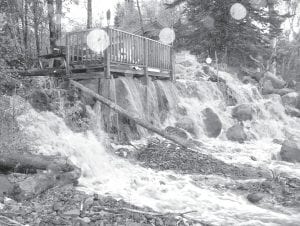Although Cook County residents are more often concerned about blizzards or wildfires, flooding can be a problem on the North Shore. This was evident in the June 6, 2008 storm in which 4 – 6.45 inches of rain fell between 2:00 and 5:00 a.m., causing streams and riverbeds to surge, washing out roads and driveways and flooding basements all over the county. With the significant snowfall received this year, there is a potential for the 2011 spring thaw to become spring flooding.
During the spring, frozen land prevents melting snow or rainfall from seeping into the ground. Each cubic foot of compacted snow contains gallons of water and once the snow melts, it can result in the overflow of streams, rivers, and lakes. Add spring storms to that and the result is often serious spring flooding.
According to the Federal Emergency Management Agency (FEMA), 90 percent percent of all natural disasters in the U.S. involve flooding and 20 percent of flood insurance claims come from outside high-risk areas.
It’s important to be prepared for flooding no matter where you live, but particularly if you are in a low-lying area, near water or downstream from a dam. Even a very small stream or dry creek bed can overflow and create flooding.
Floods do more than damage property; they can also threaten lives if safety precautions are not followed. “Floods occur somewhere in the United States or its territories nearly every day of the year, killing nearly 100 people on average annually and causing damage in the billions of dollars,” said Jack Hayes, Ph.D., director of the National Weather Service. “Awareness, preparedness and action are the key ingredients to protecting lives and property when floods threaten. One essential safety tip is to never cross a road that is covered by water. Remember, Turn Around, Don’t Drown.”
According to the National Weather Service, more deaths occur due to flooding each year than from any other severe weather-related hazard. The main reason is people underestimate the force and power of water. All areas of the country can be at risk for flooding and when such conditions are forecast, important information and life-saving alerts are available at www.weather.gov.
More than half of all flood-related deaths result from vehicles being swept downstream. Remember flash flooding can take only a few minutes to a few hours to develop. Be prepared to take detours and adjust your route due to road closures if there is standing water. As little as six inches of water may cause you to lose control of your vehicle. Flood water may be much deeper than it appears as the roadbed may be washed out. Be especially cautious at night when it is harder to recognize flood dangers.
FEMA and NOAA’s National Weather Service provide tips and information to help individuals and families prepare for flooding dangers throughout the spring season. These include learning about their risk of flooding, having an emergency preparedness kit, storing important documents in a safe place and considering the purchase of flood insurance. The resources found on-line at www.ready.gov/floodawareness.
It’s a good idea to have an emergency kit at your house in case of flooding, windstorms, extended power outages or wildfires. Suggested items for an emergency kit are:
.D rinking water
. Canned-no-cook food such as bread, crackers, dried fruits
.N on-electric can opener
. Baby food and formula (if you have a baby)
. Prescription drugs and other medicine
. First-aid kit
. Flashlight and extra batteries
. Battery-powered lamps or lanterns
. Battery-powered radio, and extra batteries



Loading Comments